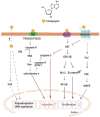The Anticancer Properties of Cordycepin and Their Underlying Mechanisms
- PMID: 30287757
- PMCID: PMC6212910
- DOI: 10.3390/ijms19103027
The Anticancer Properties of Cordycepin and Their Underlying Mechanisms
Abstract
Cordyceps is a genus of ascomycete fungi that has been used for traditional herbal remedies. It contains various bioactive ingredients including cordycepin. Cordycepin, also known as 3-deoxyadenosine, is a major compound and has been suggested to have anticancer potential. The treatment of various cancer cells with cordycepin in effectively induces cell death and retards their cancerous properties. However, the underlying mechanism is not fully understood. Recent evidence has shed light on the molecular pathways involving cysteine-aspartic proteases (caspases), mitogen-activated protein kinases (MAPKs), and glycogen synthase kinase 3 beta (GSK-3β). Furthermore, the pathways are mediated by putative receptors, such as adenosine receptors (ADORAs), death receptors (DRs), and the epidermal growth factor receptor (EGFR). This review provides the molecular mechanisms by which cordycepin functions as a singular or combinational anticancer therapeutic agent.
Keywords: Cordyceps; adenosine receptors; anticancer; cordycepin; death receptors.
Conflict of interest statement
The authors declare no conflicts of interest.
Figures

Similar articles
-
Anticancer and antimetastatic effects of cordycepin, an active component of Cordyceps sinensis.J Pharmacol Sci. 2015 Jan;127(1):53-6. doi: 10.1016/j.jphs.2014.09.001. Epub 2014 Oct 2. J Pharmacol Sci. 2015. PMID: 25704018 Review.
-
Cordycepin (3'-deoxyadenosine) inhibits the growth of B16-BL6 mouse melanoma cells through the stimulation of adenosine A3 receptor followed by glycogen synthase kinase-3beta activation and cyclin D1 suppression.Naunyn Schmiedebergs Arch Pharmacol. 2008 Jun;377(4-6):591-5. doi: 10.1007/s00210-007-0218-y. Epub 2007 Dec 15. Naunyn Schmiedebergs Arch Pharmacol. 2008. PMID: 18084742
-
The Role of Autophagy in Anti-Cancer and Health Promoting Effects of Cordycepin.Molecules. 2021 Aug 16;26(16):4954. doi: 10.3390/molecules26164954. Molecules. 2021. PMID: 34443541 Free PMC article. Review.
-
Cordycepin, 3'-deoxyadenosine, prevents rat hearts from ischemia/reperfusion injury via activation of Akt/GSK-3β/p70S6K signaling pathway and HO-1 expression.Cardiovasc Toxicol. 2014 Mar;14(1):1-9. doi: 10.1007/s12012-013-9232-0. Cardiovasc Toxicol. 2014. PMID: 24178833
-
Induction of apoptosis by cordycepin via reactive oxygen species generation in human leukemia cells.Toxicol In Vitro. 2011 Jun;25(4):817-24. doi: 10.1016/j.tiv.2011.02.001. Epub 2011 Feb 15. Toxicol In Vitro. 2011. PMID: 21310227
Cited by
-
Antitumor Mechanism and Therapeutic Potential of Cordycepin Derivatives.Molecules. 2024 Jan 18;29(2):483. doi: 10.3390/molecules29020483. Molecules. 2024. PMID: 38257396 Free PMC article.
-
Synthesis and Characterization of NUC-7738, an Aryloxy Phosphoramidate of 3'-Deoxyadenosine, as a Potential Anticancer Agent.J Med Chem. 2022 Dec 8;65(23):15789-15804. doi: 10.1021/acs.jmedchem.2c01348. Epub 2022 Nov 23. J Med Chem. 2022. PMID: 36417756 Free PMC article.
-
Metabolites and Their Bioactivities from the Genus Cordyceps.Microorganisms. 2022 Jul 24;10(8):1489. doi: 10.3390/microorganisms10081489. Microorganisms. 2022. PMID: 35893547 Free PMC article. Review.
-
Mechanism of Cordyceps sinensis and its Extracts in the Treatment of Diabetic Kidney Disease: A Review.Front Pharmacol. 2022 May 13;13:881835. doi: 10.3389/fphar.2022.881835. eCollection 2022. Front Pharmacol. 2022. PMID: 35645822 Free PMC article. Review.
-
Endothelial Nitric Oxide Mediates the Anti-Atherosclerotic Action of Torenia concolor Lindley var. Formosama Yamazaki.Int J Mol Sci. 2020 Feb 24;21(4):1532. doi: 10.3390/ijms21041532. Int J Mol Sci. 2020. PMID: 32102326 Free PMC article.
References
-
- Cassileth B.R. Alternative and complementary cancer treatments. Oncologist. 1996;1:173–179. - PubMed
Publication types
MeSH terms
Substances
Grants and funding
LinkOut - more resources
Full Text Sources
Other Literature Sources
Research Materials
Miscellaneous

